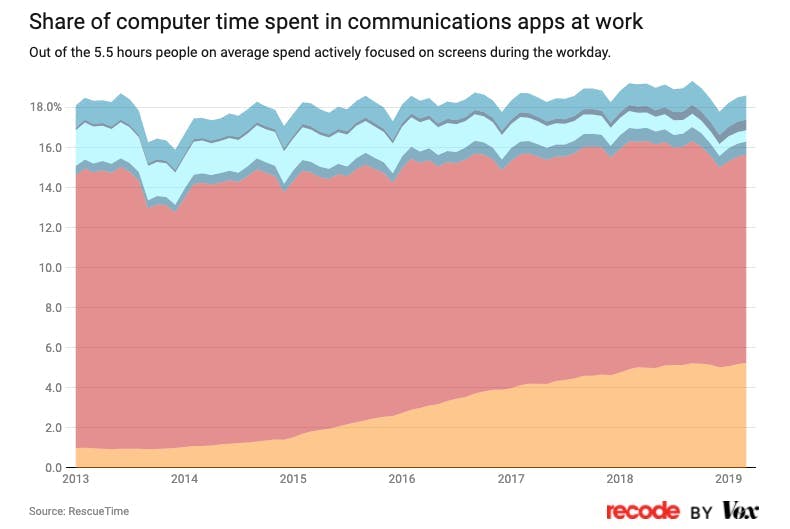Slack is not asynchronous (and what to do about it)

As someone who has worked for partially and fully distributed organizations for almost a decade, every company I've worked for has used workplace chat. My career began using Hipchat (RIP) and Slack arrived a year later, quickly becoming the de-facto tool for small and growing startups.
I loved how expressive Slack felt thanks to emojis and gifs. Today, Microsoft Teams and Slack are used by hundreds of millions of people across the world. Last week, Google launched chat as part of Workspace, a competing product baked into GSuite which highlights the reality that workplace chat is now a de-facto communication tool for work.
Slack in particular is a useful collaboration tool. It helps organizations coordinate work from a distance, including my company. Instead of sending emails back and forth, I use Slack instead. It's much more efficient for internal, real-time collaboration.
I want to see more companies shift to a work-from-anywhere model, so I'm grateful for tools like Slack as many people would be going back to the office right now if they didn't exist. Workplace chat is the gateway drug for office-centric cultures to begin shifting towards a remote-first model.
But this is the issue. It's a gateway, not the destination.
In the rest of this post, I'm going to explain why Slack is not an asynchronous communication tool, and why that's a problem, especially in a remote-first world that will demand more and more flexibility. The purpose of this post is not to criticize Slack, but instead, to highlight a shift that needs to happen. Workplace chat tools won't get us to where we need to go to truly tap into the power of working from anywhere.
Let's start off by discussing a big, fancy sounding word.
What is asynchronous communication?
Asynchronous communication is when two (or more) people can communicate without the requirement that they be present at the same exact moment in time.
Unlike a phone call or a Zoom meeting, asynchronous communication is intrinsically a more flexible way to work, as the communication is not dependent on someone else. There's no coordination cost. It gives the recipient of the message flexibility in when they can respond to you. Async puts the power into the recipient's hands vs. the sender. Fewer communication dependencies = a more flexible work environment.
When is asynchronous communication ideal?
This is not the easiest question to answer as communication is multi-faced and evolves quickly. With that being said, there's quite a bit of research on this topic that spans decades. For example, according to the media synchronicity theory, communication has two key components:
- Conveyance - The transmission of new information and the processing of that information by the receiver
- Convergence - the process of mutually agreeing on the meaning of the information (or failing to agree)
If you need to converge, build shared meaning, and resolve ambiguity, you should use gravitate towards synchronous communication. The reasoning is obvious: you need a fast feedback loop between individuals to build shared understanding that real-time communication encourages. This is why discussing complex issues is best done in-person or over a Zoom call instead of email. You need the quick back-and-forth discussion, tone of voice, and body language to give you enough data to establish common ground.
Chat: ideal for back-and-forth
If you think about a day at the office, a message in Slack is the digital equivalent of someone walking up to your desk and tapping you on the shoulder. Sometimes it's important and relevant, but these taps can also be annoying and distracting. Workplace chat at its best is a quick interaction between yourself and a coworker that allows you to converge and build shared understanding without a meeting.
What happens when your day at the office is filled with people tapping you on the shoulder? You get distracted, stressed, and are unable to do deep, meaningful work. Sure, you have fewer meetings and less email, but these activities are replaced by something else - chat. To illustrate my point, look at how much time we spend using communication tools:

As you can see in the data above, the amount of time we spend in email has migrated to chat in recent years, but the collective time spent is still the same, in fact, it's higher! According to Microsoft research, when teams went remote at the start of the COVID-19 pandemic, managers spent 115% more messages! Management by walking around has been replaced by management by chatting around.
Real-time incentives
The core value of Slack is the quick-fire interactions between coworkers, so they are incentivized to encourage this behavior, especially when onboarding new accounts. It's the "aha" moment after all.
Similar to social media companies, Slack has been laser-focused on user engagement and depth of usage for years, which is why:
- They reported on daily active users for years (Facebook does too)
- They regularly report on the amount of time spent in the app
- Pricing is based on the number of active users.
- New accounts are automatically enrolled in the most aggressive notifications from the start, pinging you at various hours of the day unless you disable them.
Workplace chat = the open office floor plan (in the cloud)
Slack wants to be the black hole that sucks you, your team, and your apps into the platform. It's good for business, but a disaster for your productivity. Slack is like the open-office floor plan. It breaks down barriers to collaboration, but didn't account for the reality that this is way of working should happen some of the time, but not all the time.
According to RescueTime, 40% of knowledge workers never get 30 minutes of focused time in a workday. During my short stint at the office, people would need to put on headphones to be able to focus. Now, you need to go into do-not-disturb in Slack. Workplace chat has literally brought the open office floor plan into the cloud.
Doubling down on real-time
If we look at Slack's product roadmap, they are doubling down on real-time communication, such as:
- Audio rooms: a legitimately good idea that will reduce Zoom meetings and fatigue. This is a synchronous communication.
- Slack connect: chat with customers, prospects, and clients in addition to coworkers (MOAR NOISE)
I can't blame them. Synchronous communication is the core value of the product, so it makes sense to go deeper here. But let's not pretend that Slack is an asynchronous communication tool.
Slack is not asynchronous (and why it matters)
This leads me to the main point - Slack is not an asynchronous communication tool. In fact, it revolves around the the need to be constantly present. It's built into every part of the product!
- Each employee's status is projected for all to see - this is the digital version of the "butts in seats" mentality, where presence means that work is getting done.
- Immediate response expected - When presence is coupled with a nudge, the expectation is that the recipient will respond immediately. If I walked up to you and tapped you on the shoulder, you would respond right away. No?
- A synchronous-first roadmap - mentioned earlier, Slack is doubling down on real-time communication.
- Quick-fire responses - Workplace chat tools encourage you to respond quickly, oftentimes with half-thought out responses. Almost every workplace issue I've personally been a part of has been a byproduct of a quick-fire response in Slack (sometimes my own doing). Async communication at its best is thoughtful and well-structured. It's an extension of having enough space to think (and calm yourself down)
Who cares?
Here's why you should care - if you want to create a flexible work environment (the #1 benefit to working from anywhere), you need to shift away from the constant chatter and need to be present. Unfortunately, Slack and other workplace chat tools are a roadblock to an evolution that needs to happen, especially in an age of never ending meetings and Zoom fatigue.
Slack is well aware of the shift towards a flexible workplace. They champion these ideas in blog posts and marketing pages (to which I give them kudos).
Example #1 (source)

Example #2 (source)

"That's your problem, you need to configure your account"
Naysayers will point out that these concerns are your problem and not the fault of the tool. After all, if you visit your account settings, on some obscure page you can disable notifications, set working hours, and install bots to help you focus.
I find this point to be total nonsense.
The tools we build are an expression of how we view the world and what we truly value. If Slack wanted to create a more flexible workplace, reduce noise, and help people focus - they could make changes and introduce improved default settings for all customers. They have an army of data scientists that could analyze the constant presence problem if it was a top priority.
They have the power, but like social media apps, they've created a hungry, reinforcing feedback loop that eats away at your time and attention, with a never-ending desire to consume more of your day.
What do we do instead?
There's a mountain of evidence that shows us a way out of this conundrum. To be clear, I do not think the right answer is ditching Slack. Instead, you and your team need to learn how to tame it. If Slack is best for quick, back and forth collaboration, we shouldn't say goodbye. That's like a carpenter refusing to use a screwdriver because it doesn't work on nails.
Let's look at what the best companies do to solve this problem.
I've written about this before, but every thoughtful, remote-first company that has been working in a distributed way for a while has manually created their own complementary tool to workplace chat. This is because they understand that the key to working from anywhere is to go async-first. This happens of out necessity as you grow, but it also helps create a more flexible work environment and tap into the benefits.
Examples:
- Zapier created Async
- Automattic created P2
- Shopify has Vault
- Gitlab uses their forum/issue software
- Stripe has Home
Here's how the folks at Zapier describe their tool:
"Async is an internal tool we built. It's sort of like a blog meets reddit. This is the place where we surface important conversations that might get lost in the fast-paced Slack. It replaces internal email and acts as a great archive for anyone on the team to reference old discussions and keep up with company updates. Slack is where we talk about work, while Async is where we share work with the rest of the team.
"Slack is where we talk about work, while Async is where we share work with the rest of the team."
These companies understand that they need to create a home for the most important stuff at work, free from the noise and chatter. An announcement from the CEO could show up next to discussion about lunch and puppies in Slack. There's a need to separate the signal from the noise.
At Friday, we've built software to accelerate the transition to a more flexible and asynchronous way of working. It's based on the best practices found in the tools listed above. While we still use Slack to collaborate (in fact, we integrate with them), we've been able to create a digital office that feels like a library instead of a noisy open-office floor plan. Feel free to give it a try for free and let me know what you think.
In conclusion
The sooner you realize that the key to distributed work success is a more flexible and async-first approach, the sooner you will realize that your reliance on workplace chat is a roadblock to this better way of working.
The tools of yesterday won't get us to where we need to go in the future. It's time to stop replicating a busy office online, but instead, to rethink the way we work and communicate.
p.s. - I'm open-sourcing a book on working from anywhere that drops in July called the Anywhere Operating System. Feel free to check it out!


